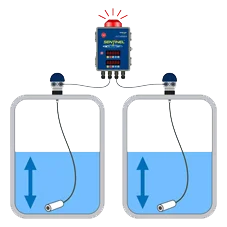When to Use a Tank Level Alarm

Available high level alarms for tanks come in a variety of designs, including:
Mechanical float switches: These gadgets make use of floats that are connected to switches. The switch, which activates the alarm, is turned on as the fluid level in the tank rises, which causes the float to rise as well.
Electro-mechanical level switches: These gadgets work by using a probe that is put into the tank. As the fluid level in the tank increases, the probe makes contact with the fluid and turns on the switch, which sounds the alarm.
One kind of level sensor that is intended to be submerged in the liquid being measured is a submersible level sensor. It is frequently utilized in deep tanks, wells, boreholes, and other hard-to-reach storage areas.
Ultrasonic level sensors: These sensors gauge a fluid’s distance from the surface using ultrasonic sound waves. A signal from the sensor is sent to the alarm, which sets off the alert as the fluid level in the tank rises.
Radar level sensors: To determine how close a liquid is to the surface, these sensors use radar technology. A signal from the sensor is sent to the alarm, which sets off the alert as the fluid level in the tank rises.
Sensors that measure capacitance: These sensors gauge the amount of liquid in a tank by using the capacitance measuring technique. A signal from the sensor is sent to the alarm, which sets off the alert as the fluid level in the tank rises.
High level alarms must be inspected frequently to make sure they are functioning; it is crucial to remember this.
Learn more about tank level sensors
Learn more about tank level alarms
Please contact us to discuss your application


